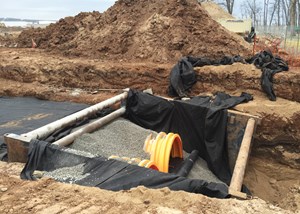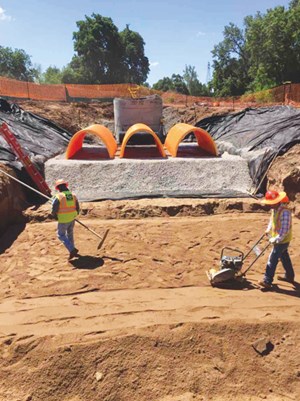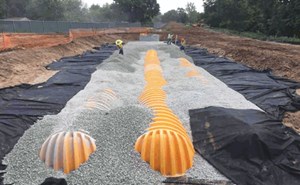December 2019 Vol. 74 No. 12
Features
Stormwater Drainage for One of the World’s Best Playgrounds
The Gathering Place is a $400 million project in Tulsa created by the George Kaiser Family Foundation that transformed Tulsa’s iconic waterfront along the scenic Arkansas River into a dynamic, interactive environment. Named by National Geographic as one of the top 12 playgrounds, it is the largest private/public park in the world, and the number one Tulsa attraction.
In 2014, Gathering Place broke ground, and the first guests entered on Sept. 8, 2018. Five acres of the current 66-acre site include playgrounds with 160 activities along with zip lines, suspension bridges, sculptures plus natural hills, meadows and paths. A skateboard park and basketball courts give teenagers and young adults abundant opportunities to enjoy the public space and the riverfront environment.
Built on the edge of the Arkansas River, the area is prone to flooding when the river rises and also from typical rain storms. This was due mainly to the undersized pipelines along with any runoff from roads and highways that would also flow onto the Blair Mansion property where the Gathering Place is now situated. The city of Tulsa funded $41 million of critical infrastructure improvements near the site before work could commence. While the land is owned by the George Kaiser Family Foundation, the utilities including the stormwater system are owned and maintained by the city of Tulsa.
For the Gathering Place’s underground stormwater system, more than four miles of pipe was called for along with 750 domed chambers that would control and slow the flow of the stormwater into the Arkansas River.
“Originally, reinforced concrete pipe (RCP) was specified but changed to thermoplastic pipe due to substantial cost savings and its ability to be rapidly installed,” explained Ron Egge, engineer, Sherwood Construction Company of Tulsa. “One of the hurdles we had was that this job was a Privately Funded, Public Improvement – PFPI – project with the city of Tulsa. The city didn’t allow plastic pipe at the time; however, they did allow it on this job after we got going. This change saved the owner a lot of money plus made it possible to do the installation a lot faster.”
Long life cycle
Designed for a 100-year storm event, the stormwater system used 15,000 feet of ADS HP Storm polypropylene pipe in diameters from 12 to 24 inches, 8,000 feet of N-12 high-density polyethylene (HDPE) pipe plus Nyloplast Water Control Structures. To detain and slow the outflow of stormwater runoff, two containment systems using 750 MC-3500 StormTech chambers were constructed, one under each parking lot. Total retention beds with water quality units were installed in the sandy soil to recharge the groundwater onsite.
The first bed was 16 by 267 feet with 72 chambers. It has a total installed volume capacity of 12,452 cubic feet of water, while the second bed is 23 by 100 feet with 42 chambers has 7,428 cubic feet of installed capacity. Each has 12 feet of cover. The chambers are made from an engineered grade of impact-modified polypropylene copolymer and designed for a 75-year service life.
Each MC-3500 chamber, without end caps, measures 90 inches long by 77 inches wide and 45 inches high and has an installed volume of 178.7 cubic feet of water. ADS N-12 18-inch diameter high-density polyethylene (HDPE) pipe was used to connect the chambers.
According to Daniel Currence, P.E., director of engineering for the Drainage Division of the Plastics Pipe Institute Inc. “because Tulsa granted a waiver specifically for the use of thermoplastic pipe at the Gathering Place, the project was able to be under budget as compared to using concrete structures and pipe. The use of thermoplastic pipe and structures made it possible for the landscape architect to make on-site changes after the drainage system was installed. These changes could be readily accomplished with a small crew using even hand tools to change and move the pipe, and with as little disruption to the nearly finished landscaping.”
“Another nice thing about using plastic in this job was doing the many changes after it was installed. It was a lot easier using plastic pipe than it would have been with concrete pipe,” Egge stated. “It was the same way with the Nyloplast structures.”
“In a lot of places, the architect would come out, look at the way the landscaping was done and say, ‘it doesn’t feel right’. It was really handy to be able to take out, cut the pipe, put in a fitting, adjust it and adjust the structure to the right height you wanted.”
Generally, there were two or three Sherwood crews onsite, each with an operator, a foreman plus three laborers. “Because of the pipe we used, we could have a smaller crew. And second, the equipment didn’t have to be nearly as big,” he continued. “This also helped a lot because we were in such confined areas doing the changes. We needed to use small equipment so we could get in and out. For a lot of the change orders, because of the pipe and size and weight of it, we could actually go in by hand without much equipment and make those changes without destroying major areas of the landscape.” •
The Plastics Pipe Institute, Inc. (PPI) is the major North American trade association representing all segments of the plastic pipe industry and is dedicated to promoting plastic as the materials of choice for pipe and conduit applications. PPI is the premier technical, engineering and industry knowledge resource publishing data for use in the development and design of plastic pipe and conduit systems. Additionally, PPI collaborates with industry organizations that set standards for manufacturing practices and installation methods.







Comments